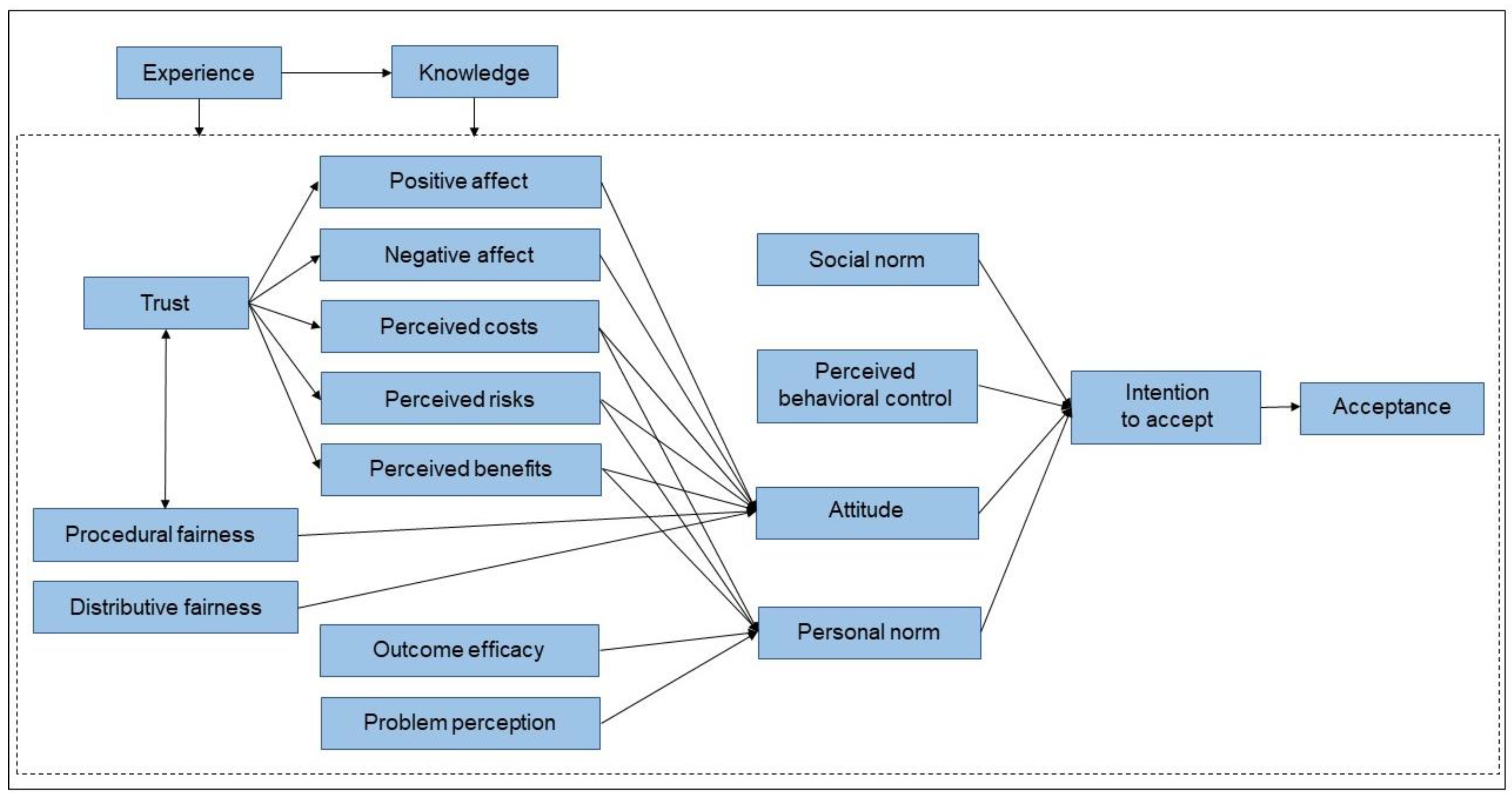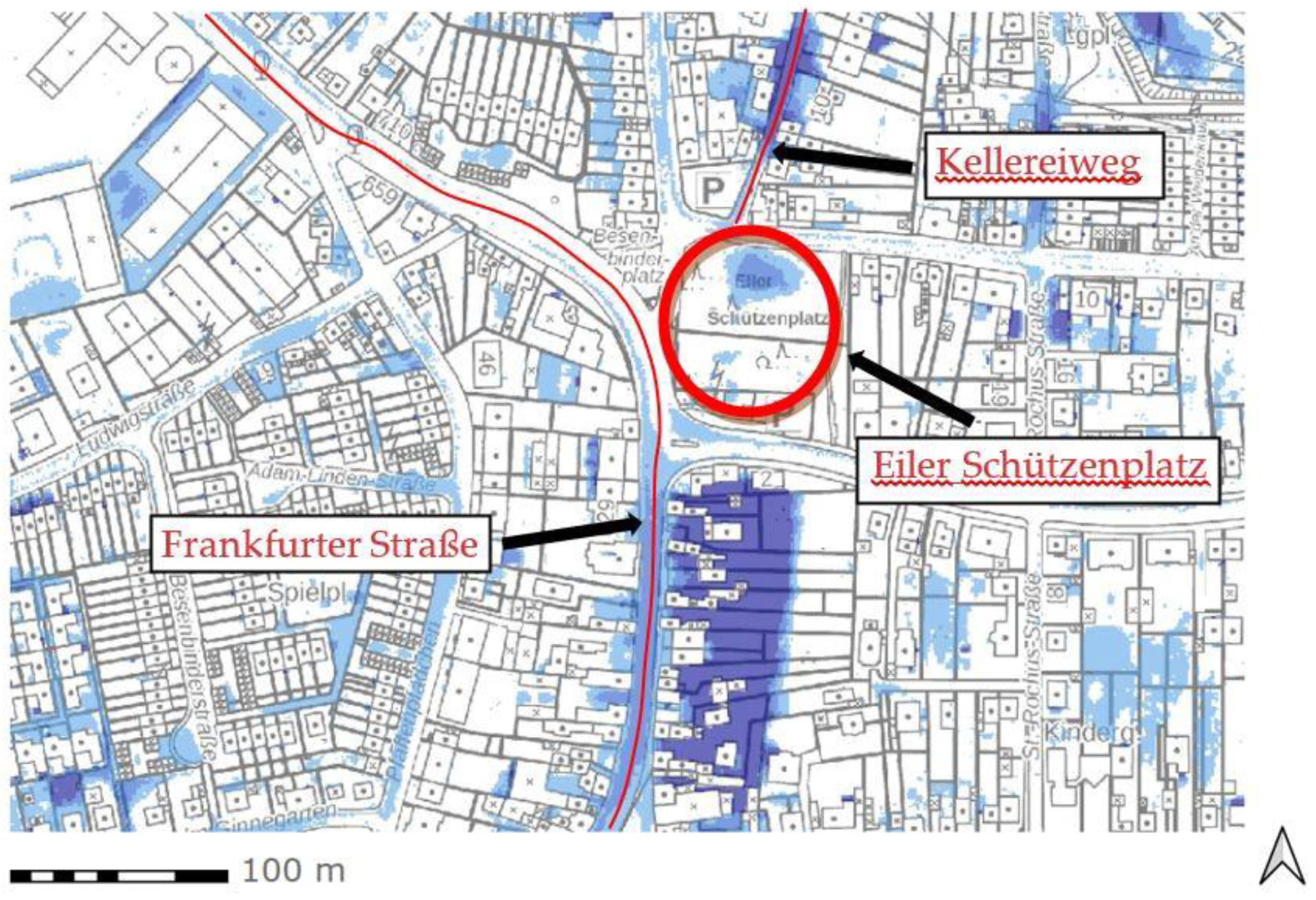Understanding Public Acceptance of a Multifunctional Water Plaza: A Case Study
Abstract
:1. Introduction
2. Methodology
2.1. Acceptance Models
2.2. Water Plazas as Urban Climate Adaption Measures
2.3. Study Area
2.4. Data Collection and Analysis
3. Results
3.1. Factors Crucial to Public Acceptance of Multifunctional Urban Stormwater Infrastructure
3.1.1. Locals Experience with Heavy Precipitation, Their Knowledge and Perception of the Construction
3.1.2. Flood Risk Perception and Efficacy Assessment
3.1.3. Perceived Advantages, Disadvantages and Risks
3.1.4. Social and Personal Norms
3.1.5. Perceived Responsibility of Flood Protection and Trust in Those Responsible
3.1.6. Public Participation and Perceived Influences
3.2. Five Types of Acceptance and Non-Acceptance of Multifunctional Urban Stormwater Infrastructure
4. Discussion
5. Recommendations
Author Contributions
Funding
Institutional Review Board Statement
Informed Consent Statement
Data Availability Statement
Conflicts of Interest
Appendix A
| Category | Questions |
|---|---|
| Interest | Are you interested in the topic of heavy precipitation? |
| Experience | Have you ever experienced heavy rain? Did you suffer any damage as a result? |
| Risk and problem perception | What do you think: How will heavy precipitation events develop in the future? Do you think heavy precipitation events are going to be a problem in future? Do you know the heavy precipitation hazard map? Have you ever heard of problems after heavy precipitation here in the neighborhood? |
| Responsibility | Who do you think is responsible for pluvial flood protection? Do you have any responsibility yourself? |
| Trust | To what extent do you trust these institutions (to adequately protect you against pluvial flooding)? |
| Current state of the Eiler Schützenplatz and usage | How do you normally use the park? |
| Knowledge | Do you know about a planned reconstruction of this park? What is planned here? |
| Acceptance | How do you assess the use of this area for water storage after heavy precipitation? Would you like to prevent the implementation? |
| Advantages | What are the advantages of such a use? Who benefits from the redesign? |
| Disadvantages & Risks | Do you think there are any risks? What are the disadvantages of such use? |
| Outcome-Efficacy | Do you think that this form of use can contribute to the effective solution of the flood problem? |
| Costs and distributional fairness | How would you assess the costs? How do you assess the distribution of costs/benefits/risks? Is the distribution fair in your opinion? |
| Social and personal norms | Have you ever talked to others about this planned multifunctional area? Do you feel a social pressure in terms of acceptance of this area? Do you feel obliged by your own value codex to do something for or against the reconstruction? |
| Public participation | Did you notice that there was a public participation event? To what extent would you have wanted to be involved in the decision-making process? |
| Influences & perceived behavioural control | Do you think you could have influenced implementation? Would it be difficult for you or would it be easy for you to do something for or against these construction measures? |
| Procedural fairness | How would you assess the process? Can you assess whether the decision-making process was fair? |
| Personal consternation | Do you feel affected by the planned reconstruction? |
References
- IPCC. Climate Change 2014: Synthesis Report. Contribution of Working Groups I, II and III to the Fifth Assessment Report of the Intergovernmental Panel on Climate Change; IPCC: Geneva, Switzerland, 2014.
- Gabe, J.; Trowsdale, S.; Mistry, D. Mandatory urban rainwater harvesting: Learning from experience. Water Sci. Technol. 2012, 65, 1200–1207. [Google Scholar] [CrossRef] [PubMed]
- DWA-M 119. In Risikomanagement in der Kommunalen Überflutungsvorsorge für Entwässerungssysteme bei Starkregen, [Translation: Risk management in Municipal Flood Prevention for Drainage Systems in the Event of Heavy Precipitation]; Deutsche Vereinigung für Wasserwirtschaft, Abwasser und Abfall: Hennef, Germany, 2016; ISBN 978-3-88721-392-3.
- Mees, H.; Driessem, P.P.J. Adaptation to climate change in urban areas: Climate-greening London, Rotterdam, and Toronto. Clim. Law 2011, 2, 251–280. [Google Scholar] [CrossRef]
- Fletcher, T.D.; Shuster, W.; Hunt, W.F.; Ashley, R.; Butler, D.; Arthur, S.; Trowsdale, S.; Barraud, S.; Semadeni-Davies, A.; Bertrand-Krajewski, J.-L.; et al. SUDS, LID, BMPs, WSUD and more—The evolution and application of terminology surrounding urban drainage. Urban Water J. 2015, 12, 525–542. [Google Scholar] [CrossRef]
- Hua, P.; Yang, W.; Qi, X.; Jiang, S.; Xie, J.; Gu, X.; Li, H.; Zhang, J.; Krebs, P. Evaluating the effect of urban flooding reduction strategies in response to design rainfall and low impact development. J. Clean. Prod. 2020, 242, 118515. [Google Scholar] [CrossRef]
- Turco, M.; Brunetti, G.; Palermo, S.A.; Capano, G.; Grossi, G.; Maiolo, M.; Piro, P. On the environmental benefits of a permeable pavement: Metals potential removal efficiency and Life Cycle Assessment. Urban Water J. 2020, 17, 619–627. [Google Scholar] [CrossRef]
- Ghodsi, S.H.; Zahmatkesh, Z.; Goharian, E.; Kerachian, R.; Zhu, Z. Optimal design of low impact development practices in response to climate change. J. Hydrol. 2020, 580, 124266. [Google Scholar] [CrossRef]
- Palermo, S.A.; Talarico, V.C.; Turco, M. On the LID systems effectiveness for urban stormwater management: Case study in Southern Italy. IOP Conf. Ser. Earth Environ. Sci. 2020, 410, 12012. [Google Scholar] [CrossRef]
- Lin, J.-Y.; Yuan, T.-C.; Chen, C.-F. Water Retention Performance at Low-Impact Development (LID) Field Sites in Taipei, Taiwan. Sustainability 2021, 13, 759. [Google Scholar] [CrossRef]
- Biesbroek, G.R.; Termeer, C.J.A.M.; Klostermann, J.E.M.; Kabat, P. Rethinking barriers to adaptation: Mechanism-based explanation of impasses in the governance of an innovative adaptation measure. Glob. Environ. Chang. 2014, 26, 108–118. [Google Scholar] [CrossRef]
- Dircke, P.; Molenaar, A. Climate change adaptation; innovative tools and strategies in Delta City Rotterdam. Water Pract. Technol. 2015, 10, 674–680. [Google Scholar] [CrossRef]
- Sales-Ortells, H.; Medema, G. Microbial health risks associated with exposure to stormwater in a water plaza. Water Res. 2015, 74, 34–46. [Google Scholar] [CrossRef] [PubMed]
- Benden, J. Multifunktionale Flächennutzung als Beitrag zur urbanen Starkregenvorsorge [Translation: Multifunctional areas as a contribution to urban heavy precipitation precaution]. Korresp. Abwasser Abfall 2015, 62, 130–137. [Google Scholar]
- Benden, J.; Broesi, R.; Illgen, M.; Leinweber, U.; Lennartz, G.; Scheid, C.; Schmitt, T.G. Multifunktionale Retentionsflächen. Teil 3: Arbeitshilfe für Planung, Umsetzung und Betrieb [Translation: Multifunctional Retention Areas. Part 3: Working Aid for Planning, Implementation and Operation]. MURIEL Publikation. Available online: https://www.dbu.de/OPAC/ab/DBU-Abschlussbericht-AZ-32223_03.pdf, (accessed on 23 February 2021).
- Illgen, M.; Leinweber, U.; Benden, J.; Broesi, R.; Scheid, C.; Schmitt, T.G.; Lennartz, G. Multifunktionale urbane Retentionsräume: Ergebnisse und Erkenntnisse aus dem praxisorientierten Forschungsprojekt MURIEL [Translation: Multifunctional urban retention areas: Results and findings from the practice-oriented research project MURIEL]. Korresp. Wasserwirtsch. 2018, 11, 94–99. [Google Scholar]
- Kind, C.; Kaiser, T.; Riese, M.; Bubeck, P.; Müggenburg, E.; Thieken, A.; Schüller, L.; Fleischmann, M. Vorsorge Gegen Starkregenereignisse und Maßnahmen zur Wassersensiblen Stadtentwicklung—Analyse des Standes der Starkregenvorsorge in Deutschland und Ableitung zukünftigen Handlungsbedarfs [Translation: Precautions against Heavy Precipitation Events and Measures for Water-Sensitive Urban Development—Analysis of the Status of Heavy Precipitation Precautions in Germany and Derivation of Future Need for Action]; Umweltbundesamtes: Dessau-Roßlau, Germany, 2019.
- Friedl, C.; Reichl, J. Realizing energy infrastructure projects—A qualitative empirical analysis of local practices to address social acceptance. Energy Policy 2016, 89, 184–193. [Google Scholar] [CrossRef]
- Dhakal, K.P.; Chevalier, L.R. Managing urban stormwater for urban sustainability: Barriers and policy solutions for green infrastructure application. J. Environ. Manage. 2017, 203, 171–181. [Google Scholar] [CrossRef] [PubMed]
- Cohen, J.J.; Reichl, J.; Schmidthaler, M. Re-focussing research efforts on the public acceptance of energy infrastructure: A critical review. Energy 2014, 76, 4–9. [Google Scholar] [CrossRef]
- Bertsch, V.; Hall, M.; Weinhardt, C.; Fichtner, W. Public acceptance and preferences related to renewable energy and grid expansion policy: Empirical insights for Germany. Energy 2016, 114, 465–477. [Google Scholar] [CrossRef]
- Acatech. Akzeptanz von Technik und Infrastrukturen, [Translation: Acceptance of Technology and Infrastructures]; Springer: Berlin/Heidelberg, Germany, 2011; ISBN 978-3-642-20743-3. [Google Scholar]
- Schäfer, M.; Keppler, D. Modelle der technikorientieren Akzeptanzforschung: Überblick und Reflexion am Beispiel eines Forschungsprojekts zur Implementierung Innovativer Technischer Energieeffizienz-Maßnahmen, [Translation: Models of Technology-Oriented Acceptance Research. Overview and Reflection Using the Example of a Research Project for the Implementation of Innovative Technical Energy Efficiency Measures]. Discussion Paper No. 34. 2013. Available online: http://www.tu-berlin.de/ztg/menue/publikationen/discussion_papers/ (accessed on 3 April 2018).
- Lucke, D. Akzeptanz: Legitimität in der, Abstimmungsgesellschaft [Translation: Acceptance. Legitimacy in the Voting Society]; VS Verlag für Sozialwissenschaften: Wiesbaden, Germany, 1995; ISBN 978-3-8100-1496-2. [Google Scholar]
- Schweizer-Ries, P. Energy sustainable communities: Environmental psychological investigations. Energy Policy 2008, 36, 4126–4135. [Google Scholar] [CrossRef]
- Hofinger, G. Denken über Umwelt und Natur, [Translation: Thinking about the Environment and Nature], 1. Aufl.; Beltz, PVU: Weinheim, Germany, 2001; ISBN 978-3621275057. [Google Scholar]
- Sauer, A.; Frieder, L.; Suda, M.; Weiland, U. Steigerung der Akzeptanz von FFH-Gebieten, [Translation: Increasing the acceptance of FFH areas.]. BfN-Skripten. 2005. Available online: https://www.bfn.de/fileadmin/BfN/service/Dokumente/skripten/Skript144.pdf (accessed on 23 February 2021).
- Huijts, N.M.A.; Molin, E.J.E.; Steg, L. Psychological factors influencing sustainable energy technology acceptance: A review-based comprehensive framework. Renew. Sustain. Energy Rev. 2012, 16, 525–531. [Google Scholar] [CrossRef]
- Kuller, M.; Farrelly, M.; Deletic, A.; Bach, P.M. Building effective Planning Support Systems for green urban water infrastructure—Practitioners’ perceptions. Environ. Sci. Policy 2018, 89, 153–162. [Google Scholar] [CrossRef]
- Roovers, G.J.; van Buuren, M.W. Stakeholder participation in long term planning of water infrastructure. Infrastruct. Complex 2016, 3, 216. [Google Scholar] [CrossRef] [Green Version]
- Venkataramanan, V.; Packman, A.I.; Peters, D.R.; Lopez, D.; McCuskey, D.J.; McDonald, R.I.; Miller, W.M.; Young, S.L. A systematic review of the human health and social well-being outcomes of green infrastructure for stormwater and flood management. J. Environ. Manag. 2019, 246, 868–880. [Google Scholar] [CrossRef]
- Schwerdorf, I.; Werker, H.; Waser, J. Der Kölner Weg der Überflutungsvorsorge, [Translation: The Cologne way of flood prevention]. Korresp. Wasserwirtsch. 2018, 11, 100–106. [Google Scholar]
- Stadtentwässerungsbetriebe Köln. Starkregengefahrenkarte [Translation: Heavy Precipitation Hazard Map]. Available online: https://www.hw-karten.de/index.html?Module=Starkregen# (accessed on 5 August 2020).
- Henschel, F. Umbau von zwei öffentlichen Platzflächen in Köln-Porz-Eil zu multifunktionalen Freiräumen mit Retentionsfunktion: Überflutungsbetrachtung, [Translation: Conversion of two public areas in Cologne-Porz-Eil into multifunctional open spaces with retention functions. Flood consideration]. 2018. [Google Scholar]
- Förder Landschaftsarchitekten GmbH. Entwurf—Eiler Schützenplatz—Übersicht: Projekt: Neugestaltung Plätze in Köln-Eil, [Translation: Draft—Eiler Schützenplatz—overview. Project: Redesign of areas in Cologne-Eil]. 2018. Available online: https://ratsinformation.stadt-koeln.de/getfile.asp?id=698674&type=do&, (accessed on 23 February 2021).
- Förder Landschaftsarchitekten GmbH. Umgestaltung multifunktionale Freiräume in Porz-Eil: Eiler Schützenplatz—Erläuterungsbericht, [Translation: Redesign of multifunctional open areas in Porz-Eil. Eiler Schützenplatz—explanatory report]. Available online: https://ratsinformation.stadt-koeln.de/getfile.asp?id=698675&type=do&, (accessed on 23 February 2021).
- Kuckartz, U. Einführung in die Computergestützte Analyse Qualitativer Daten, [Translation: Introduction to the Computer-Aided Analysis of Qualitative Data], 3., Aktualis. Aufl.; VS, Verl. für Sozialwiss: Wiesbaden, Germany, 2010; ISBN 978-3-531-16661-2. [Google Scholar]
- Jacobs, K.; Lebel, L.; Buizer, J.; Addams, L.; Matson, P.; McCullough, E.; Garden, P.; Saliba, G.; Finan, T. Linking knowledge with action in the pursuit of sustainable water-resources management. Proc. Natl. Acad. Sci. USA 2016, 113, 4591–4596. [Google Scholar] [CrossRef] [Green Version]
- Röschel, L.; Davis, M.; Naumann, S. Integrating user preferences into urban green and blue infrastructure planning: Insights from Halle, Germany and Stockholm, Sweden. In The Sustainable City XIII., Proceedings of the SUSTAINABLE CITY 2019, Valencia, Spain, 1–3 October 2019; Mambretti, S., Miralles i Garcia, J.L., Eds.; WIT Press: Southampton, UK, 2019; pp. 233–244. [Google Scholar]





Publisher’s Note: MDPI stays neutral with regard to jurisdictional claims in published maps and institutional affiliations. |
© 2021 by the authors. Licensee MDPI, Basel, Switzerland. This article is an open access article distributed under the terms and conditions of the Creative Commons Attribution (CC BY) license (http://creativecommons.org/licenses/by/4.0/).
Share and Cite
Netzel, L.; Drewing, E.; Netzel, L.; Denecke, M. Understanding Public Acceptance of a Multifunctional Water Plaza: A Case Study. Water 2021, 13, 576. https://doi.org/10.3390/w13040576
Netzel L, Drewing E, Netzel L, Denecke M. Understanding Public Acceptance of a Multifunctional Water Plaza: A Case Study. Water. 2021; 13(4):576. https://doi.org/10.3390/w13040576
Chicago/Turabian StyleNetzel, Leon, Emily Drewing, Louis Netzel, and Martin Denecke. 2021. "Understanding Public Acceptance of a Multifunctional Water Plaza: A Case Study" Water 13, no. 4: 576. https://doi.org/10.3390/w13040576






